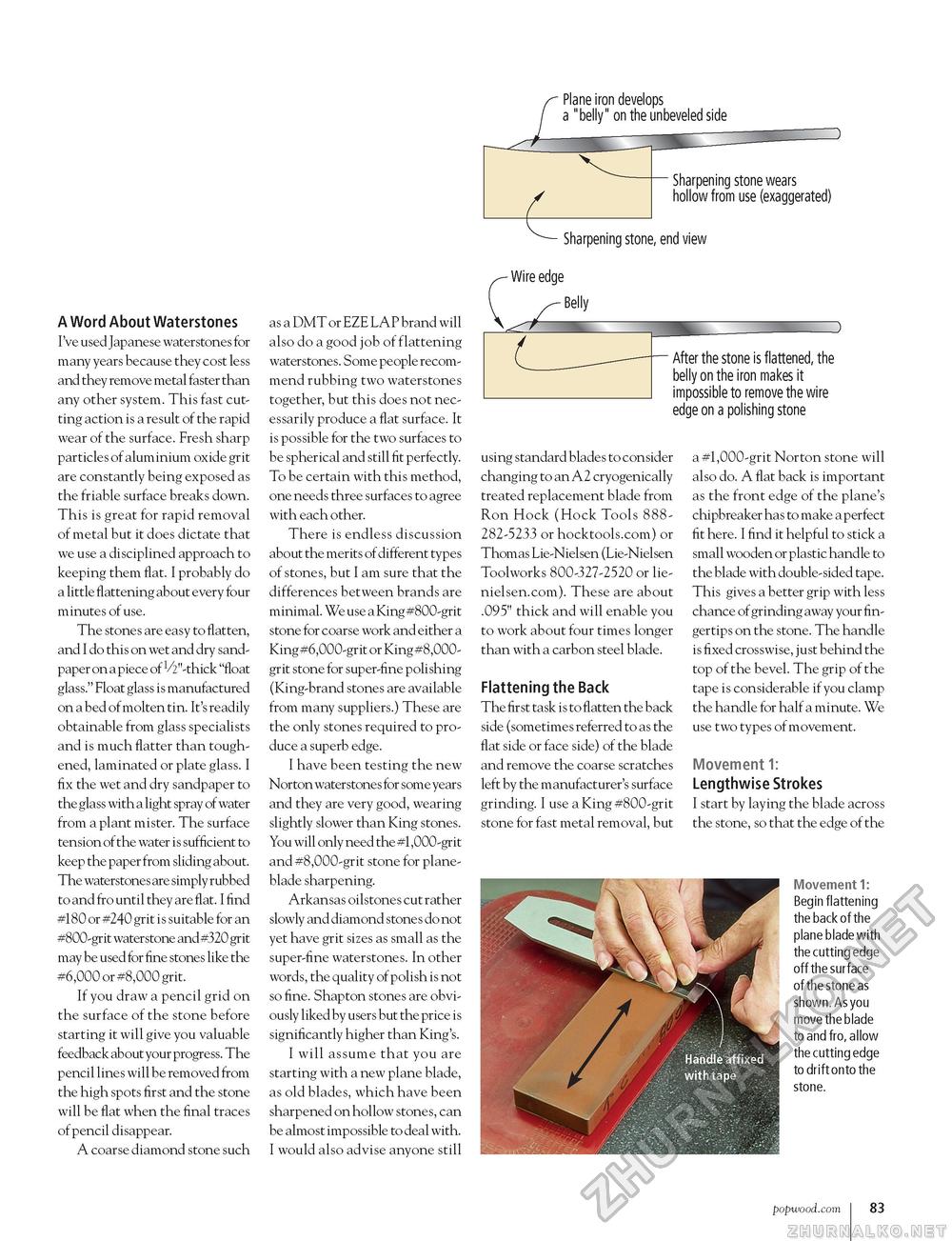Popular Woodworking 2004-11 № 144, страница 84
Plane iron develops a "belly" on theunbeveled side Sharpening stonewears hollowfrom use (exaggerated) Sharpening stone, end view - Wire edge After the stone is flattened, the belly on the iron makes it impossible to remove the wire edge on a polishing stone A Word About Waterstones I've used Japanese waterstones for many years because they cost less and they remove metal faster than any other system. This fast cutting action is a result of the rapid wear of the surface. Fresh sharp particles of aluminium oxide grit are constantly being exposed as the friable surface breaks down. This is great for rapid removal of metal but it does dictate that we use a disciplined approach to keeping them flat. I probably do a little flattening about every four minutes of use. The stones are easy to flatten, and I do this on wet and dry sandpaper on a piece of V2"-thick "float glass." Float glass is manufactured on a bed of molten tin. It's readily obtainable from glass specialists and is much flatter than toughened, laminated or plate glass. I fix the wet and dry sandpaper to the glass with a light spray of water from a plant mister. The surface tension of the water is sufficient to keep the paper from sliding about. The waterstones are simply rubbed to and fro until they are flat. I find #180 or #240 grit is suitable for an #800-grit waterstone and #320 grit may be used for fine stones like the #6,000 or #8,000 grit. If you draw a pencil grid on the surface of the stone before starting it will give you valuable feedback about your progress. The pencil lines will be removed from the high spots first and the stone will be flat when the final traces of pencil disappear. A coarse diamond stone such as a DMT or EZE LAP brand will also do a good job of flattening waterstones. Some people recommend rubbing two waterstones together, but this does not necessarily produce a flat surface. It is possible for the two surfaces to be spherical and still fit perfectly. To be certain with this method, one needs three surfaces to agree with each other. There is endless discussion about the merits of different types of stones, but I am sure that the differences between brands are minimal. We use a King #800-grit stone for coarse work and either a King #6,000-grit or King #8,000-grit stone for super-fine polishing (King-brand stones are available from many suppliers.) These are the only stones required to produce a superb edge. I have been testing the new Norton waterstones for some years and they are very good, wearing slightly slower than King stones. You will only need the #1,000-grit and #8,000-grit stone for plane-blade sharpening. Arkansas oilstones cut rather slowly and diamond stone s do not yet have grit sizes as small as the super-fine waterstones. In other words, the quality of polish is not so fine. Shapton stones are obviously liked by users but the price is significantly higher than King's. I will assume that you are starting with a new plane blade, as old blades, which have been sharpened on hollow stones, can be almost impossible to deal with. I would also advise anyone still using standard blades to consider changing to an A2 cryogenically treated replacement blade from Ron Hock (Hock Tools 888282-5233 or hocktools.com) or Thomas Lie-Nielsen (Lie-Nielsen Toolworks 800-327-2520 or lie-nielsen.com). These are about .095" thick and will enable you to work about four times longer than with a carbon steel blade. Flattening the Back The first task is to flatten the back side (sometimes referred to as the flat side or face side) of the blade and remove the coarse scratches left by the manufacturer's surface grinding. I use a King #800-grit stone for fast metal removal, but a #1,000-grit Norton stone will also do. A flat back is important as the front edge of the plane's chipbreaker has to make a perfect fit here. I find it helpful to stick a small wooden or plastic handle to the blade with double-sided tape. This gives a better grip with less chance of grinding away your fingertips on the stone. The handle is fixed crosswise, just behind the top of the bevel. The grip of the tape is considerable if you clamp the handle for half a minute. We use two types of movement. Movement 1: Lengthwise Strokes I start by laying the blade across the stone, so that the edge of the Movement 1: Begin flattening the back of the plane blade with the cutting edge off the surface of the stone as shown. As you move the blade to and fro, allow the cutting edge to drift onto the stone. popwood.com 83 |








